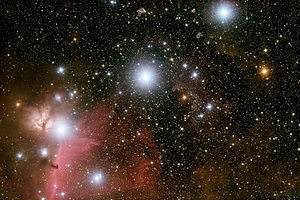 This piece was originally broadcast on Radio Scilly in January 2019. Orion is one of the gems of the Winter sky. Right now, this unmistakeable constellation, famous for its ‘belt’ of 3 stars in a row, lies due south in the sky and is clearly visible as soon as it’s decently dark. As I speak, that’s roughly 6.30/7pm. Orion’s a really rewarding constellation for beginners and experts alike, as it has lots of items of interest. Orion was a hunter in Greek mythology, a rather good one, as he managed to place Zeus (king of the gods) in the sky, as the constellation Orion. To find our hunter in the sky, look south and find the constellation with its 4 corners and distinctive 3-star belt. As you’re looking at it, the top left and bottom right of the 4 corners are interesting to observe. The top left, Betelgeuse, is a red giant star nearing the end of its life; you can clearly see it has any orangey hue, almost (but not quite) to rival that of Mars. Contrast Betelgeuse with the blue tint of the bottom-right star of Orion; Rigel (or, if you must, Rigel just like Nigel) is a blue supergiant and the 6th brightest star in the night sky. Look directly at the stars to get the best of their colour; for even more pronounced viewing, grab a pair of binoculars. The great Orion Nebula hangs below Orion’s belt. It can clearly be recognised with the naked eye as something other than a star…something more…nebulous. It’s a place – in our Milky Way – where stars are born: literally. It is a stellar nursery. Stick your binoculars – or even a modest telescope – in that direction, and you’re in for a treat. Orion is the centrepiece object of the Campaign for Rural England’s Star Count 2019, running throughout February, designed to survey the darkness (or lack thereof) of England’s night skies. Find – again, the 4 corner stars of Orion; these will give you a rectangle. Allow your eyes to adjust for, say, 15 minutes. Now, with the naked eye, how many stars can you count within that rectangle? You can’t count the 4 corners but you can count the 3 in the belt. To give you an idea, if you can count less than 10, you’re somewhere rather light polluted. If you can count more than 30, you’re looking at truly dark skies! In the Campaign for Rural England’s recent Night Blight report, Scilly was recorded to have the darkest skies of anywhere in the UK – and long may that continue. So get out there and prove it. Finally, the Observatory on St Martins will be officially open to the public from 1 April. We’ll be shortly publishing our schedule of events for the season shortly. In the meantime, if you want to find out more or have a look around, do get in touch. Happy stargazing.
0 Comments
Your comment will be posted after it is approved.
Leave a Reply. |
BYCharlie Payne POSTS
September 2024
|

 RSS Feed
RSS Feed